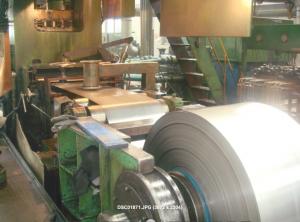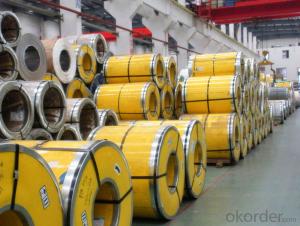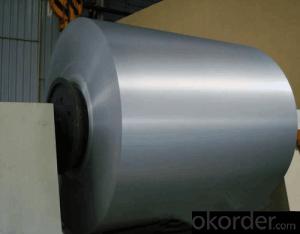201 Stainless Steel Coil / Sheet
- Loading Port:
- China Main Port
- Payment Terms:
- TT or LC
- Min Order Qty:
- 20 Ton m.t.
- Supply Capability:
- 20000 per month m.t./month
OKorder Service Pledge
OKorder Financial Service
You Might Also Like
201 Stainless Steel Coil / Sheet
1.Size of 201 Stainless Steel Coil : Thickness: 0.3mm ~~ 6mm, Width: 650mm ~~ 2100mm, Length: to be customized.
2.Material of 201 Stainless Steel Coil :SUS201,202,301,304,304L,316,316L ,321 etc.
3.Standard of 201 Stainless Steel Coil :AISI,JIS,GB,DIN
4.Finish of 201 Stainless Steel Coil :Black, No.1, 2B, 2D, BA, NO.3, NO.4, SB, NO.8, HL
5.Testing of 201 Stainless Steel Coil :Each heat number and batch must be tested for both chemical and mechanical properties
Stainless Steel Coil / Sheet | |
Standard | JIS, AISI, ASTM, GB, DIN, EN |
Property | Stainless steel coil, Stainless steel sheet, Stainless steel plate, stainless steel |
Length | 1-12m |
Quality | prime |
Manufacturing Process | factory direct sale |
Surface Treatment | Black, No.1, 2B, 2D, BA, NO.3, NO.4, SB, NO.8, HL |
Main Grade | 201,201,301,302,303,304,321,316,316L,309,310,309H, 310S,431,430,420,430F |
Model Number | 304 stainless steel channel,201 stainless steel channel |
MOQ | 20 ton |
Trade Term | FOB China mainport |
Payment term | T/T or L/C |
Price | negotiable |
Packing | Export packing |
Dilvery time | 20days or depend on order quantity |
Container | The capacity for a 20" container:20-24tons |
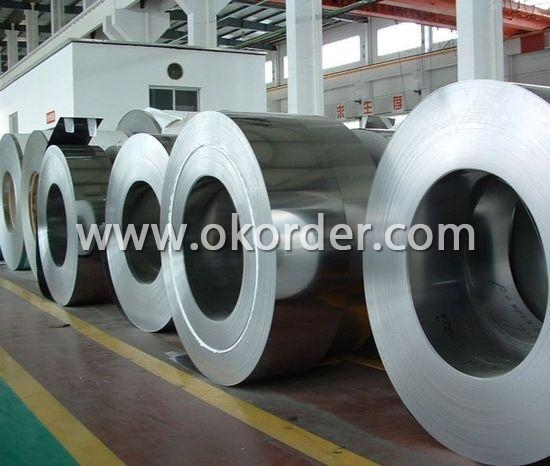
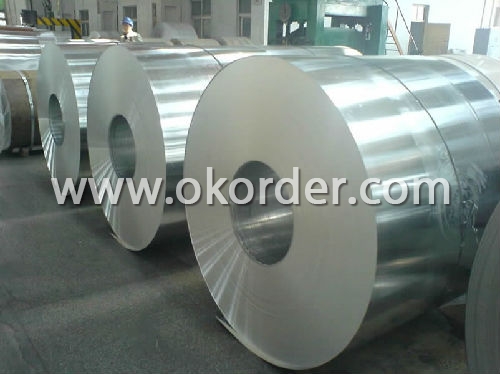
- Q:Can stainless steel strips be used in the electronics manufacturing industry?
- Yes, stainless steel strips can be used in the electronics manufacturing industry. They are commonly used for various applications such as shielding, grounding, and structural components in electronic devices. Stainless steel's corrosion resistance and high strength make it suitable for these purposes.
- Q:Are stainless steel strips easy to clean and maintain?
- Stainless steel strips are renowned for their ability to resist corrosion, stains, and rust, thus making them an ideal material for a wide range of applications. When it comes to cleaning these strips, a gentle approach is key. You can employ a mild detergent or soap in combination with warm water and a soft cloth or sponge. It's important to scrub the surface in the direction of the grain to prevent any potential scratching. Once cleaned, thoroughly rinse the strips and ensure they are completely dry to avoid water spots. In terms of upkeep, maintaining stainless steel strips requires minimal effort. Regular cleaning usually suffices to keep them in pristine condition. However, should you come across stubborn stains or marks, there are stainless steel cleaners and polishes specially formulated for this purpose. These products aid in restoring the strips' luster and eliminating any residue or imperfections. Moreover, stainless steel boasts remarkable durability, eliminating the need for special treatments or coatings to preserve its quality. It is also resistant to heat, making it a suitable choice for a variety of environments, including kitchens and manufacturing facilities. All in all, thanks to their inherent qualities, stainless steel strips are relatively simple to clean and maintain. By adhering to proper cleaning techniques and utilizing appropriate products, you can ensure that your stainless steel strips remain in exceptional condition for an extended period.
- Q:Are stainless steel strips suitable for architectural mesh?
- Yes, stainless steel strips are suitable for architectural mesh. Stainless steel is a popular choice for architectural applications due to its durability, strength, and corrosion resistance. Stainless steel strips can be formed into various patterns and designs, making them ideal for creating decorative and functional architectural mesh. Additionally, stainless steel is low maintenance and can withstand harsh environmental conditions, making it a reliable choice for long-lasting architectural installations.
- Q:What are the storage and handling recommendations for 111 stainless steel strips?
- The storage and handling recommendations for 111 stainless steel strips include storing them in a clean, dry, and well-ventilated area to prevent moisture and corrosion. It is advisable to stack them on pallets or racks to avoid contact with the ground and minimize the risk of damage. Additionally, handling should be done with clean gloves or tools to prevent contamination and scratches on the surface. Regular inspection for any signs of damage or corrosion is also recommended.
- Q:Are 111 stainless steel strips suitable for automotive exhaust systems?
- Automotive exhaust systems can benefit from the use of 111 stainless steel strips. This type of stainless steel, also known as AISI 111, is highly resistant to heat, corrosion, and rust, making it a popular choice for exhaust systems. Its excellent ductility, strength, and weldability make it a suitable material for this application. It can withstand extreme temperatures and harsh conditions, ensuring long-lasting performance and durability. In addition, stainless steel strips are easily shaped and formed, allowing for precise fabrication and customization according to the specific requirements of the exhaust system design. Overall, 111 stainless steel strips possess the necessary properties and characteristics to fulfill the demands of automotive exhaust systems.
- Q:What are the typical tolerance levels for stainless steel strips?
- The tolerance levels of stainless steel strips can differ based on specific requirements and applications. Nevertheless, the industry commonly employs certain typical tolerance levels. Concerning thickness, stainless steel strips are generally specified with a plus or minus tolerance. For instance, a normal tolerance for a strip with a thickness of 0.025 inches may be +/- 0.001 inches. This implies that the strip's actual thickness can range from 0.024 inches to 0.026 inches. Similarly, the width tolerance for stainless steel strips is typically specified as a plus or minus tolerance. For example, a common tolerance for a strip with a width of 1 inch might be +/- 0.005 inches. Consequently, the strip's actual width can range from 0.995 inches to 1.005 inches. The length tolerance for stainless steel strips can also vary based on the specific application. However, it is common to specify length tolerances with a maximum deviation rather than a plus or minus tolerance. For example, a typical length tolerance for a stainless steel strip could be +/- 0.010 inches. It is essential to note that these tolerance levels serve as examples and can differ depending on the specific application requirements. It is always advisable to consult the manufacturer or supplier of the stainless steel strips to determine the appropriate tolerance levels for a particular application.
- Q:What is the thickness range of stainless steel strips?
- The thickness of stainless steel strips can vary depending on the specific application and requirements, encompassing a range. In general, these strips are offered in thicknesses between 0.02 millimeters and 5 millimeters. Nevertheless, it is crucial to acknowledge that tailored thicknesses can be produced to cater to individual needs. The choice of the suitable thickness hinges on factors including the intended purpose, structural necessities, and desired visual appeal.
- Q:What are the different types of stainless steel strip alloys?
- Stainless steel strip alloys are classified according to their chemical composition and properties, which determine their suitability for different uses. Here are several types of stainless steel strip alloys: 1. Austenitic stainless steel: This is the most commonly used stainless steel strip alloy due to its outstanding resistance to corrosion. It contains high amounts of chromium and nickel, providing stability and durability. Austenitic stainless steel is not magnetic and is frequently employed in industries like food processing, chemicals, and pharmaceuticals. 2. Ferritic stainless steel: Ferritic stainless steel strip alloys have a higher chromium content compared to other alloys. They are magnetic and exhibit good resistance to corrosion, heat, and stress. These alloys are commonly utilized in applications requiring high strength and resistance to oxidation, such as automotive exhaust systems and household appliances. 3. Martensitic stainless steel: Martensitic stainless steel strip alloys are hard and strong, making them suitable for applications that demand wear resistance and high mechanical properties. They have a higher carbon content, allowing them to be hardened through heat treatment. These alloys are frequently used in cutlery, surgical instruments, and turbine blades. 4. Duplex stainless steel: Duplex stainless steel strip alloys have a mixed microstructure of austenite and ferrite, offering a balanced combination of strength and corrosion resistance. They contain higher levels of chromium and molybdenum, making them highly resistant to stress corrosion cracking and pitting. Duplex stainless steel is commonly employed in chemical processing, oil and gas, and marine environments. 5. Precipitation-hardening stainless steel: These alloys can be heat treated to achieve high strength and hardness. They contain elements like nickel, copper, and aluminum, which form precipitates during the heat treatment process, resulting in increased strength. Precipitation-hardening stainless steel is frequently used in aerospace applications, as well as high-performance automotive components. It is important to note that each type of stainless steel strip alloy has numerous grades and variations available, each with its own specific properties and applications. Therefore, it is crucial to carefully select the appropriate alloy based on the requirements of the intended application.
- Q:Are 111 stainless steel strips suitable for welding?
- Indeed, 111 stainless steel strips prove to be excellent for welding purposes. Boasting a ferritic stainless steel grade, stainless steel 111 boasts elevated chromium levels and reduced nickel content. Such a composition endows it with remarkable resistance against corrosion and oxidation, rendering it ideal for diverse welding applications. To guarantee adequate weldability and achieve the desired strength and durability in welded joints, employing the appropriate welding technique and filler material is of utmost importance. Consequently, it is highly advisable to seek advice from welding experts or adhere to the manufacturer's instructions pertaining to the precise variant of stainless steel employed.
- Q:Can stainless steel strips be used in architectural facades?
- Yes, stainless steel strips can be used in architectural facades. Stainless steel is a durable and versatile material that offers excellent resistance to corrosion, making it suitable for outdoor applications. Its sleek and modern appearance also adds aesthetic appeal to architectural designs.
1. Manufacturer Overview |
|
|---|---|
| Location | Hebei,China |
| Year Established | 1989 |
| Annual Output Value | Above US$160 Thousand |
| Main Markets | Europe, East Asia and Southeast Asia |
| Company Certifications | ISO9001:2000; |
2. Manufacturer Certificates |
|
|---|---|
| a) Certification Name | |
| Range | |
| Reference | |
| Validity Period | |
3. Manufacturer Capability |
|
|---|---|
| a)Trade Capacity | |
| Nearest Port | Tianjin |
| Export Percentage | 70% |
| No.of Employees in Trade Department | 30 People |
| Language Spoken: | English;Chinese |
| b)Factory Information | |
| Factory Size: | Above 14,500 square meters |
| No. of Production Lines | Above 6 |
| Contract Manufacturing | OEM Service Offered;Design Service Offered |
| Product Price Range | Average |
Send your message to us
201 Stainless Steel Coil / Sheet
- Loading Port:
- China Main Port
- Payment Terms:
- TT or LC
- Min Order Qty:
- 20 Ton m.t.
- Supply Capability:
- 20000 per month m.t./month
OKorder Service Pledge
OKorder Financial Service
Similar products
New products
Hot products
Hot Searches
Related keywords
